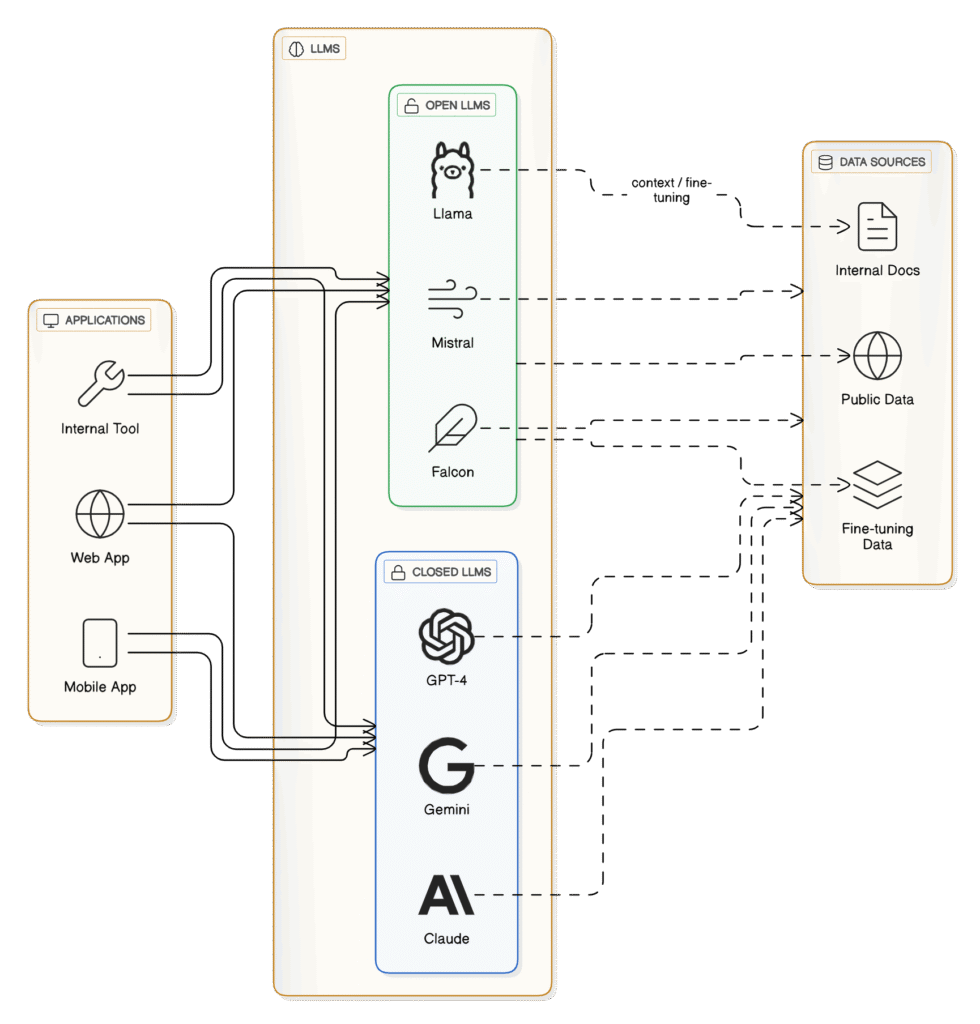Large Language Models (LLMs) are the backbone of modern Generative AI systems. They enable capabilities such as conversational AI, text generation, summarization, code assistance, and much more.
As organizations adopt LLMs to build intelligent applications, one of the first strategic decisions they face is choosing between Open LLMs and Closed LLMs.
This section provides a clear definition of each category, highlights the key differences, and offers practical insights to help you select the right approach for your business or project.

What are Open LLMs?
Open LLMs are language models whose:
· Pre-trained
model weights are publicly available
· Architectures
and training methodologies are transparent
· Licensing
terms (often permissive or open-source) allow users to:
- Download
and run models locally - Fine-tune
models on private data - Deploy
models within their own infrastructure - Audit,
modify, or extend models for specific use cases
Examples of Popular Open LLMs:
- Meta’s
LLaMA 2 & 3 - Mistral’s
7B & Mixtral - Falcon
LLM (TII) - GPT-NeoX
and GPT-J (EleutherAI) - BLOOM
(BigScience Project)
Open LLMs empower developers, researchers, and
organizations to build custom AI solutions while maintaining control over
infrastructure, privacy, and costs.
What are Closed LLMs?
Closed LLMs (also called
proprietary LLMs) are language models developed by private organizations,
where:
· Model
weights are not publicly released
· Access
is provided through controlled channels, typically via APIs
· The
internal architecture or training data details are often partially or fully
restricted
· Licensing
governs how outputs or integrations can be used
Examples of Popular Closed LLMs:
- GPT-4
& GPT-4o (OpenAI) - Claude
(Anthropic) - Gemini
(formerly Bard) (Google DeepMind) - Cohere’s
Command R series
Closed LLMs often represent the cutting edge of AI
capabilities but operate under strict platform, usage, and pricing policies.
Key Differences: Open LLMs vs Closed LLMs
|
Aspect |
Open LLMs |
Closed LLMs |
|
Model Access |
Downloadable, self-hosted |
Access via API or limited platforms |
|
Transparency |
Open architecture |
Partial or no |
|
Customization |
Full fine-tuning, domain adaptation allowed |
Limited to prompt engineering or fine-tuning APIs (if provided) |
|
Deployment Control |
Run |
Hosted by the |
|
Data Privacy |
Keeps sensitive data within your environment |
Data often transmitted to vendor’s servers |
|
Cost Structure |
One-time |
Pay-per-use |
|
Innovation Pace |
Rapid community-driven updates |
Vendor-driven with periodic major releases |
|
Compliance & |
Easier to |
Requires |
|
Performance |
Varies by model, often catching up to top-tier closed models |
Leading-edge capabilities, especially for reasoning, multi-modal tasks |
Choosing Between Open and Closed LLMs
The right choice depends on:
· Data Sensitivity: Open LLMs are ideal for
environments where data privacy, sovereignty, or compliance is critical.
· Control Requirements: Organizations
seeking full control over AI behavior, deployment, and customization often
prefer Open LLMs.
· Performance Needs: For the latest, most
advanced reasoning or multi-modal capabilities, Closed LLMs may offer better
out-of-the-box results.
· Cost Considerations: Open LLMs reduce
long-term operational costs but require initial infrastructure investment.
Closed LLMs offer faster experimentation but ongoing pay-per-use costs.
· Speed to Market: Closed LLMs simplify
rapid prototyping via APIs. Open LLMs are better suited for building deeply
integrated, production-grade systems.
Real-World Example Scenarios
|
Scenario |
Recommended LLM |
|
Building a |
Open LLM, self-hosted on secure infrastructure |
|
Rapidly prototyping |
Closed LLM |
|
Creating a custom, |
Open LLM fine-tuned on proprietary data |
|
Developing a |
Closed LLMs |
Both Open and Closed LLMs play vital roles in
the Generative AI ecosystem. By understanding their differences, organizations
can make informed decisions aligned with their technical, security, and
business objectives
